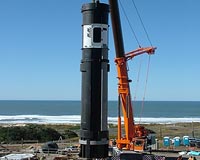| . |  |
. |
Tel Aviv, Israel (UPI) Aug 24, 2009 Israel's drive to deploy the Iron Dome anti-missile shield against short-range rockets fired by Hezbollah and Hamas has moved up a gear with the induction of the first battalion to man the batteries that will operate on the borders with Lebanon and the Gaza Strip. Iron Dome intercepted three 122mm Grad rockets, the type used by Hezbollah and the Palestinians, in southern Israel July 15-16. The system came into being in response to constant rocket attacks by Hezbollah on Israel's northern front and Hamas on the southern desert frontier over the last decade. Both fronts have been relatively calm for some time, although the threat remains palpable. Hezbollah has not fired any rockets since the end of the 34-day war with Israel in August 2006. But Israeli President Shimon Peres claimed Sunday that the Iranian-backed militants have now amassed 80,000 rockets of various calibers, some with ranges of up to 160 miles and reportedly able to reach Tel Aviv, since that conflict ended. During the 2006 war, Hezbollah unleashed some 4,000 Iranian and Syrian rockets into Israel in the most sustained bombardment of the Jewish state since it was founded in 1948. Israel was unable to knock out Hezbollah's armories, and the militants were able to fire in excess of 100 rockets a day until the final moments of the conflict. Hamas has been quiescent since Israel concluded a 22-day invasion of Gaza on Jan. 18. But it is not known how long that unofficial cease-fire will last. Israeli officials say Hamas has 10,000 rockets with ranges of up to 27 miles. There are widespread concerns in the region that Hezbollah and Israel are talking themselves into another bout of fighting, largely because Iran has refused to halt its nuclear program. The Iron Dome tests last month incorporated all the elements of the system -- the launcher and interceptor developed by state-owned Rafael Advanced Defense System, the EL/M-2084 multimission radar built by Israel Aerospace Industries' subsidiary Elta, and mPrest Systems' battle management and weapon control system. "The successful test marks the completion of the initial development phase," Pinchas Buchris, the director general of the Defense Ministry, told Jane's Defense Weekly. "From now on, our efforts will be to make the system operational as we plan initial operational capability from the first half of 2010. We're advancing even faster than the tight schedule we've set for the project." The new Iron Dome battalion is scheduled to deploy the first operational battery, with four launchers, in the southern Negev Desert near the Gaza Strip next May. Deployment along the northern border with Lebanon is expected later. The Jerusalem Post reported on Sunday that the Iron Dome battalion will be part of the Israeli military's Air Defense Division. The new unit is commanded by Lt. Col. Shabtai Ben-Boher, who until recently headed a battalion equipped with U.S.-supplied Patriot missiles. Officers with the new battalion have already begun operational training using computer simulators, and the primary task is to establish a doctrine for the system. "We can't promise 100 percent hermetic defense," a senior Air Defense Division official noted. "But what we can promise is that after years of rocket fire against Gaza-belt communities there will now be an effective solution." Iron Dome, when it is deployed, will constitute the bottom rung of a multi-layered anti-missile shield. The David's Sling system being developed by Rafael and the U.S. Raytheon Co. will cover the middle tier countering rockets with a range of 150-250 miles, primarily the Iranian-made Zelzal and Fajr rockets and Syria's M600 weapons, all believed to be in Hezbollah's possession. Ballistic missiles, such as Iran's Shehab-3 and Sejjil-2 systems, will be countered by the long-range, high-altitude Arrow-2 system developed by Israel and the United States. Share This Article With Planet Earth
Related Links Learn about missile defense at SpaceWar.com Learn about nuclear weapons doctrine and defense at SpaceWar.com All about missiles at SpaceWar.com Learn about the Superpowers of the 21st Century at SpaceWar.com
 Boeing Expands Test Capability For GMD Missile Defense System
Boeing Expands Test Capability For GMD Missile Defense SystemVandenberg AFB CA (SPX) Aug 19, 2009 Boeing, working with industry teammates and the U.S. Missile Defense Agency (MDA), has completed construction of a second interceptor test silo for the Ground-based Midcourse Defense (GMD) system at Vandenberg Air Force Base. The new underground silo provides additional test capability for the United States' only defense against long-range ballistic missile threats. "Having this second ... read more |
|
| The content herein, unless otherwise known to be public domain, are Copyright 1995-2009 - SpaceDaily. AFP and UPI Wire Stories are copyright Agence France-Presse and United Press International. ESA Portal Reports are copyright European Space Agency. All NASA sourced material is public domain. Additional copyrights may apply in whole or part to other bona fide parties. Advertising does not imply endorsement,agreement or approval of any opinions, statements or information provided by SpaceDaily on any Web page published or hosted by SpaceDaily. Privacy Statement |